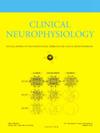Sawtooth delta of the thalamus: A physiological variant and the intracranial generator of rapid-eye movement sleep sawtooth waves
IF 3.7
3区 医学
Q1 CLINICAL NEUROLOGY
引用次数: 0
Abstract
Objective
To describe slow wave activity in the thalamic centro-median nucleus (CMN) region during rapid eye-movement (REM) sleep and its relation to the scalp EEG sawtooth waves.
Methods
Five (5) patients undergoing stereo-electroencephalography were implanted in the CMN. Sleep was scored using the concurrent scalp EEG, eye-movement artifacts in Fp1, Fp2, F7, and F8, and chin EMG.
Results
In the CMN region, blocks of successive delta waves assuming a sawtooth morphology were observed, presenting with high specificity for REM (pWvsREM < 0.00001; pNREMvsREM < 0.00001). Sawtooth delta of the thalamus (SDT) presented with discrete high-delta biphasic (∼2.5–4 Hz) and low-delta triphasic (∼1–2.5 Hz) morphologies; the former maximized in CMN space, while the latter in the adjacent ventro-lateral nucleus (VLN). The biphasic SDT’s negative peaks were time-locked to the positive peaks of REM sawtooth waves on scalp (mean lag.
16.7 ± 5.6 msec). SDT was not specific to tonic or phasic REM (p = 0.179), and was not associated with REM intracranial interictal or ictal activity.
Conclusions
SDT is a physiological variant, specific to REM sleep, manifesting with two morphologically distinct subtypes, one of them generating REM sawtooth waves on scalp.
Significance
Discriminating between this physiological variant and actual ictal neurophysiological signatures is imperative for efficient therapeutic CMN neurostimulation.
丘脑的锯齿状δ:一种生理变异和快速眼动睡眠锯齿状波的颅内发生器
目的描述快速眼动睡眠(REM)期间丘脑中中核(CMN)区域的慢波活动及其与头皮脑电图锯齿波的关系。结果在 CMN 区域,观察到具有锯齿形态的连续三角波块,对快速动眼期具有高度特异性(pWvsREM < 0.00001; pNREMvsREM < 0.00001)。丘脑锯齿δ(SDT)呈现离散的高δ双相(∼2.5-4 Hz)和低δ三相(∼1-2.5 Hz)形态;前者在 CMN 空间达到最大,而后者在邻近的腹外侧核(VLN)达到最大。双相 SDT 的负峰值与头皮上快速动眼期锯齿波的正峰值时间锁定(平均滞后 16.7 ± 5.6 毫秒)。结论SDT是快速动眼期睡眠特有的一种生理变异,表现为两种形态上截然不同的亚型,其中一种会在头皮上产生快速动眼期锯齿波。
本文章由计算机程序翻译,如有差异,请以英文原文为准。
求助全文
约1分钟内获得全文
求助全文
来源期刊

Clinical Neurophysiology
医学-临床神经学
CiteScore
8.70
自引率
6.40%
发文量
932
审稿时长
59 days
期刊介绍:
As of January 1999, The journal Electroencephalography and Clinical Neurophysiology, and its two sections Electromyography and Motor Control and Evoked Potentials have amalgamated to become this journal - Clinical Neurophysiology.
Clinical Neurophysiology is the official journal of the International Federation of Clinical Neurophysiology, the Brazilian Society of Clinical Neurophysiology, the Czech Society of Clinical Neurophysiology, the Italian Clinical Neurophysiology Society and the International Society of Intraoperative Neurophysiology.The journal is dedicated to fostering research and disseminating information on all aspects of both normal and abnormal functioning of the nervous system. The key aim of the publication is to disseminate scholarly reports on the pathophysiology underlying diseases of the central and peripheral nervous system of human patients. Clinical trials that use neurophysiological measures to document change are encouraged, as are manuscripts reporting data on integrated neuroimaging of central nervous function including, but not limited to, functional MRI, MEG, EEG, PET and other neuroimaging modalities.
 求助内容:
求助内容: 应助结果提醒方式:
应助结果提醒方式:


